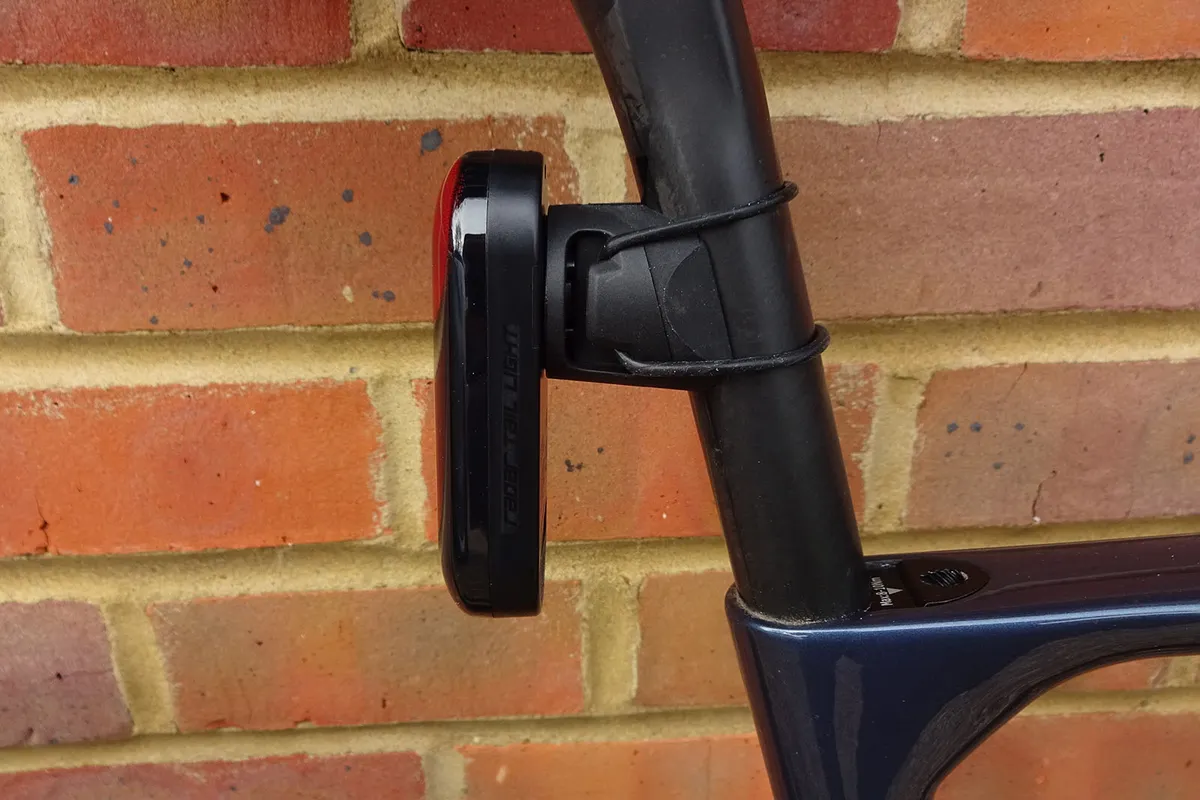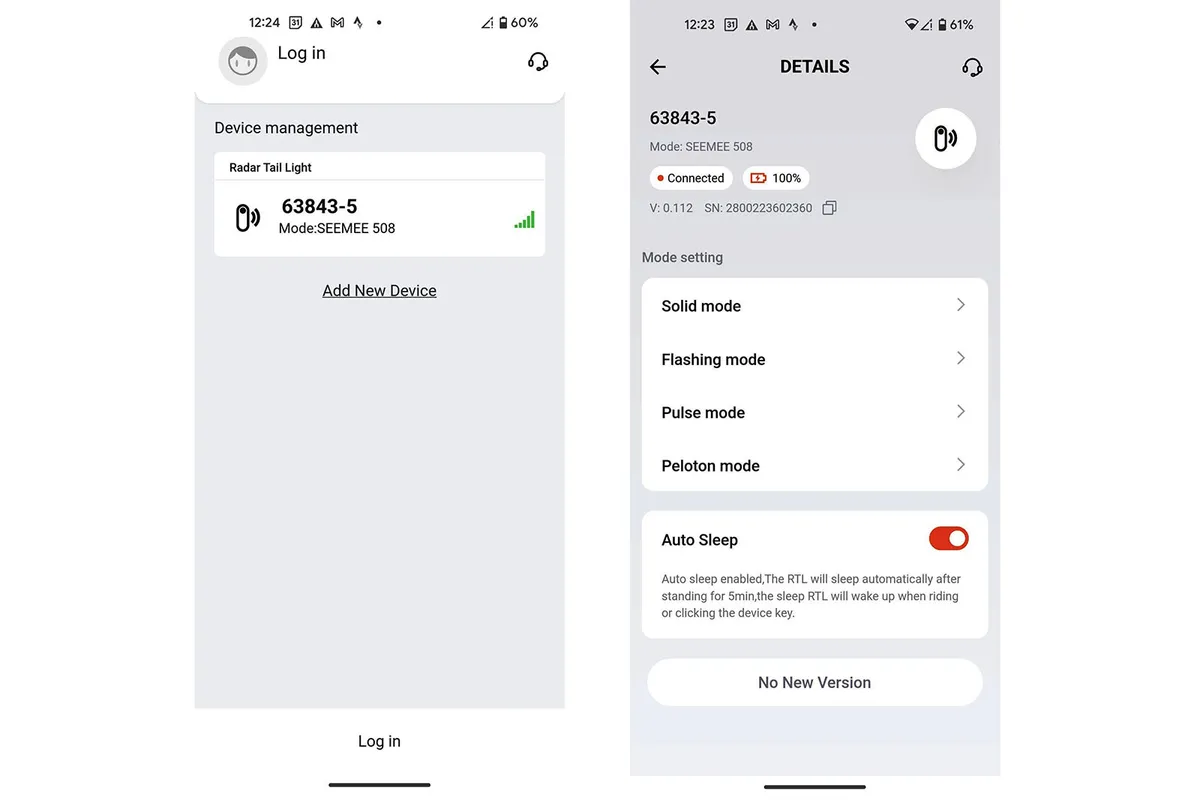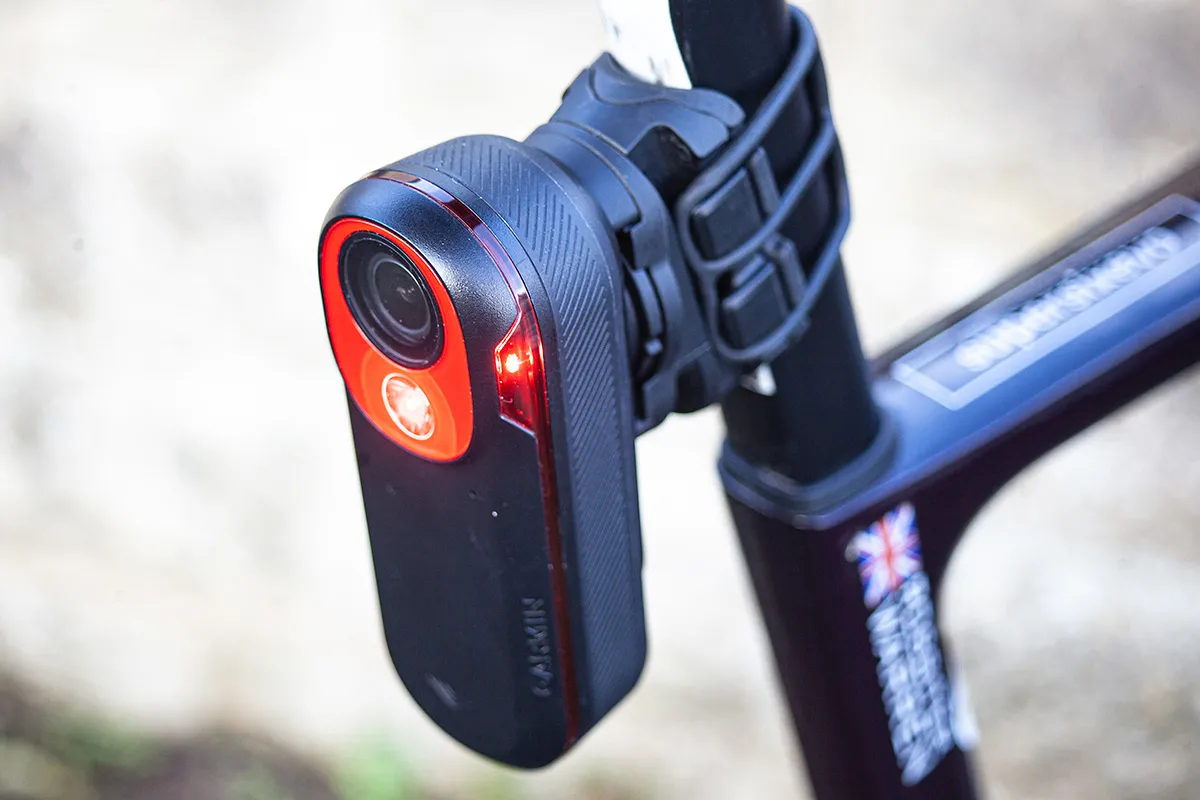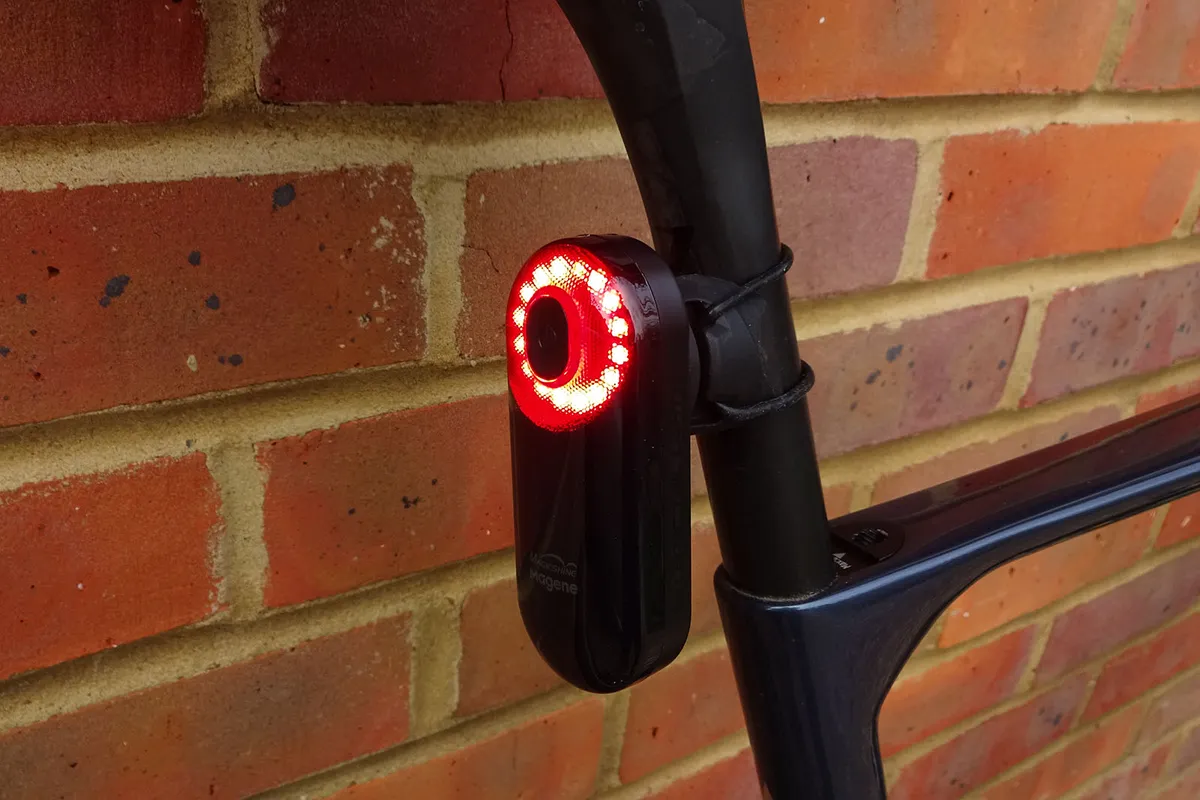The radar in the Magicshine Magene Seemee 508 is effective at detecting vehicles approaching from behind and works with a wide range of cycling computers and Garmin smartwatches.
The included tail light is highly configurable and brighter than its 20-lumen output suggests, although I found the run time to be shorter than claimed by Magicshine.
It proved effective at detecting approaching vehicles and represents a lower-priced alternative to Garmin radar lights.
Magicshine Magene Seemee 508 specifications

The Magicshine Magene Seemee 508 radar has a similar format to other rear-view radar units, with an elongated body that's 92x37x20mm (excluding the quarter-turn mount). It weighs 62g.
The rear face has a curved profile with a gloss-black finish. It feels satisfyingly like a smooth pebble and seems less susceptible to dirt than flatter, matt-finished units, although it is prone to scratches.
The top third of the unit houses a circular array of 16 LEDs behind a light diffuser, with the on/off button in its centre.
The Magicshine Magene Seemee 508 uses a mount that angles it close to horizontally backwards on your seatpost – this is necessary for the detector to work.
It’s held in place with a rubber band that sits in deep slots on either side of the mount, and Magicshine provides three lengths to suit different seatposts.
This is a similar system to that used by Garmin. It feels rather less robust than the integrated ladder mount on the Bryton Gardia R300L, although Magicshine provides a lanyard to add some extra security.
There’s a tendency for the unit to turn slightly askew when mounted on round seatposts, although this didn’t affect the radar’s effectiveness. The mount doesn’t sit very well on flat-backed seatposts either.
There’s IPX7 water resistance, so wheelspray shouldn’t be a problem and wasn’t while testing in the damp conditions this summer.
Magicshine Magene Seemee 508 radar performance

As with other rear-view radar units, the Magicshine Magene Seemee 508's main event is its radar detection of vehicles approaching from behind.
Magicshine claims detection at up to 140m distance, but as with the Garmin Varia RTL515, I suspect that on a straight road with a significant speed differential, it’s considerably greater than this.
The unit regularly detected vehicles while they were still out of earshot.
The radar uses ANT+ and BLE protocols to transmit data to a bike computer or a smartwatch.
The computer or watch sounds an alert and shows you how far behind the vehicle is via an amber or red band on the side of your screen. The vehicle appears as a dot that moves up the band as it approaches.
The exact configuration of this depends on your head unit’s software; Wahoo, for example, enables you to use its LED arrays to augment the display.
Once a vehicle has passed, you get an all-clear beep and the band turns green. A fast-approaching vehicle turns the band red.
Magicshine says the Seemee 508 is compatible with computers from Garmin, Wahoo, Bryton and Magene. However, Magicshine only supports compatibility with a subset of Garmin smartwatches and not those from other brands.
The device also works with the Hammerhead Karoo 2, although I found the black dots used to denote vehicles on the Karoo 2 harder to read than the display icons on the Wahoo Elemnt Roam and Garmin Edge 1040 computers.
Pairing with the Garmin, Wahoo and Hammerhead computers is as quick and easy as connecting any other peripheral, such as a heart rate monitor or power meter.
Pairing with a Garmin Fenix 6 smartwatch was quick, via a downloaded widget from the Garmin Connect IQ store.
Magicshine Magene Seemee 508 vehicle detection
As well as cars directly behind you, the radar will detect vehicles approaching at an oblique angle, which can be useful at junctions or on winding roads.
If you're turning, it’s handy to know whether a following vehicle has also turned. Magicshine says the radar beam angle is 40 degrees.
Vehicle detection is dependent on the relative velocity of the vehicle approaching. A car following at the same speed as you will not be detected, so often you’ll find it disappears from the screen as it slows and settles behind you, and you’ll be given a green all-clear alert.
The vehicle will then reappear on your computer once the driver makes a manoeuvre to overtake you.
Multiple vehicles approaching in convoy usually show up as multiple dots on the cycling computer screen, although I found this wasn’t always the case. Sometimes, the radar failed to detect vehicles following the first in line.
That said, this is a feature of all radar devices, not just the Magicshine, so it’s important not to assume there’s nothing else behind you once one vehicle has passed.
I also got a few false positives, which seemed to occur most often on windier days, probably due to tree branches waving in the wind.
Magicshine Magene Seemee 508 rear light
The second part of the Magicshine Magene Seemee 508’s act is its tail light. This offers seven modes in all (Magicshine seems to have added a new double-flash mode not documented on its website).
The modes available are solid, flashing, pulse, rotate and a lower-output peloton option, as well as radar only.
Magicshine has cut down on the number of configuration options it provided in a previous version of its companion app, with the main configurable item now being the rate of flashing or pulsing.
Battery life is highly dependent on how you configure the unit, but Magicshine quotes run times of 6-12 hours, or 16 hours for the radar-only mode.
Magicshine states a 20-lumen maximum output, which seems quite low. The device feels brighter than this suggests though, while the domed shape gives claimed 220-degree visibility. I didn’t feel under-illuminated riding on sunny days.
The light also acts as a brake light, with the intensity increasing and the light switching to continuous mode when you decelerate.
My favourite mode was ‘Rotate’, where all 16 LEDs are illuminated, with each shining brighter in turn, giving a display that should be unmissable.
It’s probably among the most power-hungry though. I got around four hours' riding before the unit started to run out of juice and another hour before it stopped functioning, against the 10 hours claimed. I’ve consistently achieved longer run times using the flashing mode.
You get an alert on your head unit when the light is running low on battery and another when it shuts down. On the Garmin Edge 1040, these are hard to miss, with a red box on the display and a loud alarm, which literally stopped me in my tracks to investigate.
Charging is by USB-C and takes the claimed four hours.
How does the Magicshine Magene Seemee 508 compare to the competition?

Garmin leads the pack with the range of cycling radars it offers. It has the Radar-only RVR315, radar-plus-light RTL515 and the Garmin Varia RCT715, which adds a camera to the menu.
Magicshine is offering a unit with a tail light for the same price as the radar-only Garmin Varia RVR315 and provides a lot of functionality for your cash.
Bryton offers the Gardia R300L, which is priced at £119.99.
Magicshine Magene Seemee 508 bottom line

The Magicshine Magene Seemee 508 is a good alternative to the Garmin Varia RTL515, that’s cheaper and offers similar functionality.
It’s configurable and can help you keep tabs on what’s happening behind.
As with any rear-view radar, it’s important not to rely on it and keep your ears and eyes open.
Having said that, the Magicshine Magene Seemee 508 is a capable unit that can assist you in staying alert.
Product
| Brand | Magicshine |
| Price | €140.00, £130.00, $140.00 |
| Weight | 62g |
Features
| Light type | rear |
| Integrated battery | yes |
| Features | Dimensions: 92mm x 38mm x 20mm Seatpost mount weight: 20g Modes: 6 plus radar-only Maximum output: 20 lumens Maximum run time: 12 hours claimed, 16 hours radar-only Water resistance: IPX7 |
| Output (lumens) | 20 |
